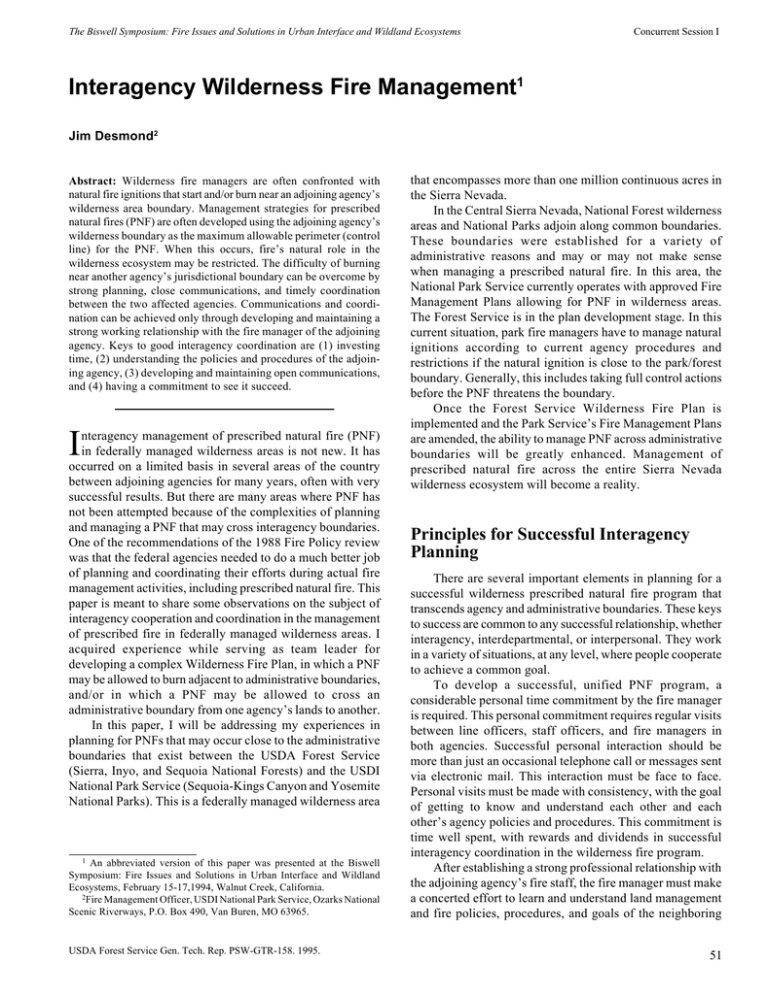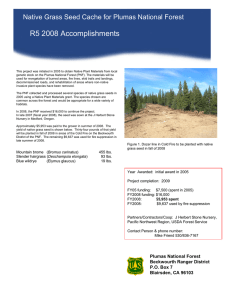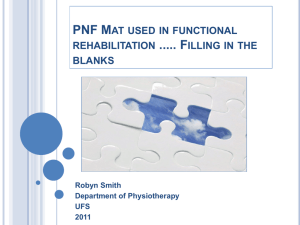that encompasses more than one million continuous acres in
advertisement

The Biswell Symposium: Fire Issues and Solutions in Urban Interface and Wildland Ecosystems Concurrent Session I Interagency Wilderness Fire Management1 Jim Desmond2 Abstract: Wilderness fire managers are often confronted with natural fire ignitions that start and/or burn near an adjoining agency’s wilderness area boundary. Management strategies for prescribed natural fires (PNF) are often developed using the adjoining agency’s wilderness boundary as the maximum allowable perimeter (control line) for the PNF. When this occurs, fire’s natural role in the wilderness ecosystem may be restricted. The difficulty of burning near another agency’s jurisdictional boundary can be overcome by strong planning, close communications, and timely coordination between the two affected agencies. Communications and coordination can be achieved only through developing and maintaining a strong working relationship with the fire manager of the adjoining agency. Keys to good interagency coordination are (1) investing time, (2) understanding the policies and procedures of the adjoining agency, (3) developing and maintaining open communications, and (4) having a commitment to see it succeed. I nteragency management of prescribed natural fire (PNF) in federally managed wilderness areas is not new. It has occurred on a limited basis in several areas of the country between adjoining agencies for many years, often with very successful results. But there are many areas where PNF has not been attempted because of the complexities of planning and managing a PNF that may cross interagency boundaries. One of the recommendations of the 1988 Fire Policy review was that the federal agencies needed to do a much better job of planning and coordinating their efforts during actual fire management activities, including prescribed natural fire. This paper is meant to share some observations on the subject of interagency cooperation and coordination in the management of prescribed fire in federally managed wilderness areas. I acquired experience while serving as team leader for developing a complex Wilderness Fire Plan, in which a PNF may be allowed to burn adjacent to administrative boundaries, and/or in which a PNF may be allowed to cross an administrative boundary from one agency’s lands to another. In this paper, I will be addressing my experiences in planning for PNFs that may occur close to the administrative boundaries that exist between the USDA Forest Service (Sierra, Inyo, and Sequoia National Forests) and the USDI National Park Service (Sequoia-Kings Canyon and Yosemite National Parks). This is a federally managed wilderness area 1 An abbreviated version of this paper was presented at the Biswell Symposium: Fire Issues and Solutions in Urban Interface and Wildland Ecosystems, February 15-17,1994, Walnut Creek, California. 2Fire Management Officer, USDI National Park Service, Ozarks National Scenic Riverways, P.O. Box 490, Van Buren, MO 63965. USDA Forest Service Gen. Tech. Rep. PSW-GTR-158. 1995. that encompasses more than one million continuous acres in the Sierra Nevada. In the Central Sierra Nevada, National Forest wilderness areas and National Parks adjoin along common boundaries. These boundaries were established for a variety of administrative reasons and may or may not make sense when managing a prescribed natural fire. In this area, the National Park Service currently operates with approved Fire Management Plans allowing for PNF in wilderness areas. The Forest Service is in the plan development stage. In this current situation, park fire managers have to manage natural ignitions according to current agency procedures and restrictions if the natural ignition is close to the park/forest boundary. Generally, this includes taking full control actions before the PNF threatens the boundary. Once the Forest Service Wilderness Fire Plan is implemented and the Park Service’s Fire Management Plans are amended, the ability to manage PNF across administrative boundaries will be greatly enhanced. Management of prescribed natural fire across the entire Sierra Nevada wilderness ecosystem will become a reality. Principles for Successful Interagency Planning There are several important elements in planning for a successful wilderness prescribed natural fire program that transcends agency and administrative boundaries. These keys to success are common to any successful relationship, whether interagency, interdepartmental, or interpersonal. They work in a variety of situations, at any level, where people cooperate to achieve a common goal. To develop a successful, unified PNF program, a considerable personal time commitment by the fire manager is required. This personal commitment requires regular visits between line officers, staff officers, and fire managers in both agencies. Successful personal interaction should be more than just an occasional telephone call or messages sent via electronic mail. This interaction must be face to face. Personal visits must be made with consistency, with the goal of getting to know and understand each other and each other’s agency policies and procedures. This commitment is time well spent, with rewards and dividends in successful interagency coordination in the wilderness fire program. After establishing a strong professional relationship with the adjoining agency’s fire staff, the fire manager must make a concerted effort to learn and understand land management and fire policies, procedures, and goals of the neighboring 51 The Biswell Symposium: Fire Issues and Solutions in Urban Interface and Wildland Ecosystems agency. Not only must fire managers understand written policy and procedures, they must seek to understand the management style and philosophy of the adjoining line officers (i.e., Park Superintendent or Forest Supervisor) and their fire staff. All line officers and fire managers bring a certain amount of their own philosophy, values, and ideas into managing the wilderness resource, and it is very important to identify these early. Knowing and understanding the policies, procedures, and personalities of the adjoining agency is very important to successful interagency coordination. Another key to success is to establish and maintain strong communications with the adjoining land management agency. “Communications” is defined as more than just talking; it is expressing oneself effectively. Communications must be open, truthful, and unselfish. An effective communicator is not only a good speaker, but also a good listener. Probably the most important key to success in developing interagency cooperation in PNF is making the personal commitment to see it succeed. The fire manager has to eliminate the “us versus them” attitude and establish a “teamwork” philosophy. The fire manager must be selfless in his concerns for the success of the overall wilderness PNF program. The fire manager must give 100 percent effort. Personal and agency pride and even “agency arrogance” must be set aside in order for interagency cooperation to succeed. The fire manager must believe from the outset that the interagency wilderness fire program will succeed. These four keys to success can be easily used in planning a cooperative interagency PNF program. Planning requires a time investment, an understanding of each other’s policies, open communications, and a commitment to success. Implementing Principles into PNF Planning Early on in the development of the Wilderness Fire Plan for the John Muir, Ansel Adams, Dinkey Lakes, and Monarch Wilderness areas, it was recognized that adjoining National Parks (Yosemite and Sequoia-Kings Canyon) had a vested interest in what the Forest Service was planning in their wilderness fire plan. A representative from the USDI National Park Service was invited to become an active participant and adviser to the USDA Forest Service Wilderness Fire Planning Team. This Park Service representative attended all planning sessions and had the opportunity to review and comment on all proposals to the plan. This interagency coordination effort was able to spot potential problems in the plan early in the draft process. Other small procedural problems, terminology changes, and/ or policy conflicts were addressed during this planning phase. As a result of this interagency planning team, many of the following procedures were developed to manage the complexities of PNF’s that occurred adjacent to or across administrative boundaries. 52 Concurrent Session I During the development of the Forest Wilderness Plan, it was determined that each central Sierra Nevada forest (Inyo, Sierra, and Sequoia) and each park (Yosemite and Sequoia-Kings Canyon) will appoint one person to serve as a Unit/Agency PNF coordinator. This group of five forest/ park liaison representatives will form the Unit/Agency PNF coordinators group. These PNF coordinators will be the primary interagency/intra-agency contacts in all matters relating to PNFs once the John Muir, Dinkey Lakes, Ansel Adams, and Monarch Fire Plan has been approved. (Note: Both parks currently have approved Fire Management Plans allowing PNF in their Wilderness Fire Zones). Once the plan is operational, the PNF coordinator will serve as liaison between ranger units, forests, and parks. The Unit/Agency PNF coordinators group’s duties and responsibilities will include attending pre-season planning and post-evaluation of the area-wide PNF program. The forest PNF coordinator will coordinate funding needs and requests before placing natural ignitions in PNF status. The coordinators may assist individual ranger units in ordering equipment, crews, and qualified personnel to manage PNF’s. They will monitor forest-wide PNF activity and may serve as advisers to the district fire managers. The Unit/Agency PNF coordinator will serve as the interagency/intra-agency contact on any boundary fire between either two ranger units, two forests, or between a forest and a park. The Unit/ Agency PNF coordinator will be the chief adviser to the appropriate line officer and forest management team. Interagency coordination is of critical importance in natural ignitions or fires that are close to administrative boundaries. Any natural ignition or fire that is within 2 miles of the administrative boundary will be called a “boundary fire.” The agency on which the fire is burning is called the “lead agency.” The agency across the boundary will be known as the “adjoining agency.” Any potential PNF within the boundary zone will require the following: (1) “lead agency” notifies “adjoining agency” of situation, (2) “lead agency” provides copy of PNF assessment and Burn Plan including map of maximum allowable perimeter (MAP) to “adjoining agency,” (3) allows the “adjoining agency” to provide input to management and strategy of the boundary PNF. This initial coordination should take place within 2436 hours. A second classification for a “boundary fire” is one in which the ignition or PNF is of “immediate threat” to the administrative boundary. This is generally considered within 0.25 mile of the boundary line. When an ignition is within this zone, both agency coordinators will perform the above procedures, plus set up the framework for a unified management team for the PNF, if it crosses the boundary. At this point, we anticipated that there would be exceptions to the above policy and procedures. Examples of these exceptions are: when the ignition or fire is a “single tree in the rocks,” or when the PNF has little potential to cross the boundary because of significant natural barriers. Unit/Agency PNF coordinators are required to come to a USDA Forest Service Gen. Tech. Rep. PSW-GTR-158. 1995. The Biswell Symposium: Fire Issues and Solutions in Urban Interface and Wildland Ecosystems mutual agreement on the strategy and tactics on any ignitions or fires within the boundary zone. Again, the key is timely coordination and good communications between the Unit/ Agency PNF coordinators. Several other procedures concerning “boundary fires” were adopted by the planning team and incorporated into the Forest Service Wilderness Fire Plan. The following are examples of a few. If any circumstance (i.e., political concerns, lack of funding, shortage of qualified personnel, etc.) occurs in which the “adjoining agency” feels uncomfortable in allowing the PNF to burn within the boundary zone, the “boundary fire” will be managed in appropriate suppression response (confine, contain, or control). Both agencies must be unified in their willingness to proceed in allowing a “boundary fire” to burn naturally within the confines of the plan. Boundary PNF’s that burn on both agencies’ lands simultaneously may require separate documentation and recordkeeping systems. Each unit will maintain its own PNF file. This file will contain documents that are specific to agency needs and requirements. Agencies are encouraged to share maps, observations, and other forms of intelligence gathered. USDA Forest Service Gen. Tech. Rep. PSW-GTR-158. 1995. Concurrent Session I Daily revalidation of “boundary fires” will require line officer signatures. If the PNF is burning on both agencies’ lands at once, line officers of both agencies will be required to sign off each day as agency policy requires. Each agency will use its own forms and procedures for this daily requirement. The utilization and coordinated use of aircraft, organized crews, and miscellaneous resources for monitoring and/or holding may be negotiated during the preliminary decision analysis of the PNF. Unit/Agency PNF coordinators will share in formulating these agreements. Conclusion The time investment, an understanding of others’ policies and procedures, strong communications, and a commitment to see interagency coordination succeed do not end when the Fire Management Plan is approved. Planning is a process that makes land management decisions and outlines how those decisions are to be implemented. Good planning can be rendered useless by poor execution. The wilderness fire manager must maintain a close relationship with neighbors by continuing a strong commitment to interagency cooperation and coordination. As stewards of the wilderness resource we should strive for no less. 53 54 USDA Forest Service Gen. Tech. Rep. PSW-GTR-158. 1995.





